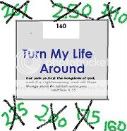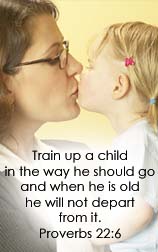It's no secret that housekeeping is not one of my strong suits. In fact, neither is figuring out the best way to get the children involved in chores. Trying to balance everything in my life is definitely a struggle, what with time with the Lord, blogging, exercise, schoolwork, and housework. It always seems as if one or more are being neglected. I know I want to make sure my children grow up knowing how to take care of household chores. This was something I wasn't really taught very well, though my mother is a stickler for a clean house. And to top it off, I tend to take after my dad more than I do my mom, a bit on the hoarder side, plus some laziness that tends to come through. I've known I need to make some changes for a while, but I just wasn't sure how to go about doing so. That is until we had the opportunity to review The Everyday Family Chore System from Everyday Homemaking thanks to the Homeschool Review Crew.
I received a downloadable, PDF copy of the 88-page The Everyday Family Chore System book by Vicki Bentley.
This book is divided into four sections.
- Introduction
- Part One: Laying a Foundation
- Part Two: Implementing the Plan
- Part Three: The Actual Chore System
In the Introduction, the author shares a bit about herself and how capable her children have been trained to be. I mean, who wouldn't want to take advice from a lady who raised children who could look after a household in an emergency? Who wouldn't want to know how a mom who successfully raised eight children (plus over 50 foster children) kept things in order? I was definitely eager to continue reading.
Part One: Laying the Foundation explains the two main purposes for implementing a family chore system. The author then moves on to the Four Basic Principles that help to lay a foundation for this system. Mrs. Bentley explains the importance of:
- having realistic and age appropriate expectations
- establishing rules or standards
- having a working knowledge of family discipline and
- tying strings to the children's hearts.
It's important to understand the different expectations you should have of children at different ages, and to know that training is going to look different depending on their ages as well. This isn't just referring to training the children in the chores either, this is talking about basic discipline, obedience, and responsibility, among other important character traits. The author explains the importance of explaining and writing down expectations, along with knowing the difference between God's rules and house rules. Before moving into the actual plan, Mrs. Bentley concludes this foundational section by reminding the reader that discipline should not be done in anger, and she also gives ways that parents can build loving relationships with their child(ren).
Part Two: Implementing the Plan gets into the nitty gritty of how this chore system works. In order to understand how to assign chores, it is important to understand which tasks a child is capable of at each age. Such a list is included. The list is divided by age, from age two through teenagers, sharing all the chores a child should be able to be taught to do. It is important to understand that children will probably not master each of these tasks at the specified age. The author added a number (in parentheses) after each chore, which represents the age at which a child should be able to master the task. Of course, this will only be accomplished if the child has been trained how to do so.
Mrs. Bentley then looks at daily versus weekly chores, and explains how the tasks will rotate. These jobs are the non-negotiable jobs which are imperative to complete each day or week. Then there are the occasional chores that need to be done. She shares some different ways these tasks have been completed in her home through the years, from Job-from-Box tasks, to different Zones, to a combination of the two.
I mentioned that the chores need to be written down so the children know what is expected of them. That is where the two main parts of this system come in.
- There are six different ways that the chore chart can be set up.
- The How-To-Do-It cards that explain how to do each chore are essential.
I used a tweaked version of Set Up #1 for our chore chart:
I used the materials I had on hand to make the chart. This includes a couple of layers of card stock for the main yellow section where the children's names are written. I used some of my old scrapbooking letters to form the phrase "Family Chores." I loved the idea of including Colossians 3:23 on the chart, so that is printed under the title. Labels with the daily and weekly tasks were attached to clothespins, which are then clipped next to each child's name. I color-coded them by coloring the morning tasks yellow and the night time tasks dark blue. The weekly tasks were left white.
The chart was completed by adding a pocket formed by folding over a piece of card stock. This is where the How-To-Do-It cards are stored. As you can see, I color coded those as well.
I decided I will be rotating our chores weekly, though Mrs. Bentley rotates hers monthly. She also had each child completing two weekly chores, where I decided to start my children with one each. We will slowly add in more chores as the children get used to doing them. Before this the children didn't have many routine chores, so I am gradually getting them used to this whole chore system idea.
I have had to play with our routine a bit to change up the chores the children used to have. Thankfully we are still off of school right now, so we have been able to get into the swing of things. I will then have to see if any adapting will be necessary once we get back into our school routine.
In addition to utilizing the chore chart . . .
. . . I have started taking some of the other advice that is included in Part Two.
There are a few pages of "Make it easy to succeed" tips. Some simple, yet important tips to remember can be found here. Such as: have a routine, have a place for everything, set a timer, and laundry the "right" way. One thing I appreciated was the list of things that the children should have done before school. I have adapted that, and made a "Things that need to be done before coming downstairs for breakfast" chart.
And we now have an after breakfast routine where they clear their spots at the table, brush their teeth, and do their morning chores before doing anything else. We also have an after dinner routine.
Part Two also contains the following: My Daily School Routine, What is a Tidy Room?, Zone Cleaning Lists, How to Do Laundry, House Rules for Older Girls While Still at Home, plus different motivations for success.
Part Three: The Actual Chore System is where you will find the Chore Labels and How-To-Do-It cards, plus instructions on how to use them.
Chore Labels:
There are three pages of 14 chore labels, plus 2 pages of blank labels. I used the blank labels to write in all of our chores as I had some different chores than were listed, plus there are a couple of tasks that I wanted different children to do at different times of the day. I felt it looked neater to use just handwritten labels to stay consistent.
How-To-Do-It Cards
These are 3 x 5 cards that explain how to do each task. There are 13 pages of four cards, plus three blank pages. I actually decided to use lined index cards to write out my own, using Mrs. Bentley's as examples. Again, this was for consistency, seeing as some of the chores on the cards were explained just a bit different than we do them, or I wanted to separate some tasks onto two cards instead of one.
Since implementing this chore system our house is running so much more smoothly, and it is staying cleaner. The children are enjoying their new responsibilities. In fact, Harold has been known to beg to do his sweeping. The older girls are even offering to help each other with their weekly tasks. It really is amazing what children are capable of doing if you just give them a chance.
I highly recommend Vicki Bentley's The Everyday Family Chore System if you are needing some order in your home. I love this chore system. It is simple to tweak it in a way that works for your family. And there are so many great tips included. If you aren't sure how to explain to a child the correct way to do a task, the How-To-Do-It cards are wonderful. They have the information right in front of them so you don't have to keep nagging at them. Check it out, and see if it will work for your family.
You can find Everyday Homemaking on Facebook.
My fellow Crew Mates and I have been reviewing either The Everyday Family Chore System or Everyday Cooking. Don't forget to stop by to see what they think of these books from Everyday Homemaking. Just click on the banner below:





































![[PREMIO2009.png]](https://blogger.googleusercontent.com/img/b/R29vZ2xl/AVvXsEjXD_Gx-wZ9EM5hXKrEYLksEBkYfRQtmb8VDVTDG_yyLggQoFIstZsh4zszdG20KqErZicRzEhiNYLty7j3IMXJYsABqkXjr8pp-ncj71xCbpxlXGbGpZq2fTuDQqq1RMKV4DPcDBnBViA/s1600/PREMIO2009.png)




I'm so glad you were able to tweak this to meet your family's needs! Thank you for your thoughtful review. :)
ReplyDelete